#and gothic scala
Explore tagged Tumblr posts
Text
Instead of the vastly interesting storyline that khml would've given us, we are back waiting for kh4 that has that ugly as fuck dollarstore bargin bin y0zora ugly fucker in it 🙄🙄🙄🙄
#letn#cannot stress enough how little i care for him and his barfin bin pals#like im soooooooo notninterested in 4 outside of like strelitzia#like fake shibuya does NOTHING for me#even the asthetic bores me bc it's just a modern city#like i LIVE in a modern city shit is boring bring back daybreak town COWARDS#and gothic scala
8 notes
·
View notes
Text





Palazzo Ducale (Venice, Italy)
#palazzo ducale#venice#venezia#italy#architecture#artedit#art#italian architecture#gothic#gothic architecture#doge palace#ceiling#scala d'oro#golden#luxury
20 notes
·
View notes
Text

Brain needs an optometrist (insp: this art by @masterfuldoodler!)
#bonus points if he also just can’t read scala script#my art#brain kh#knight in gothic armour#my posts
43 notes
·
View notes
Text
So I don't really know what to make of all this, and it very well could amount to absolutely nothing, but I think it's fun exploring anyway.
So I thought about Nebu's post that compares the pipes in the gothic Scala ad Caelum to the pipes going into the lifeboat (although their conclusion is not really what this post is about). This is a long post basically comparing the machinery in Hollow Bastion and Daybreak Town to gothic Scala ad Caelum.
I'm first reminded of how Hollow Bastion was overtaken by pipes around the time (I assume) that all its drama went down with Xehanort, Kairi, and the start of the Organization. The pipes in HB seem to grow so fast that they pierced through the building. And while later referenced (KH2’s HB castle has cranes cleaning up the pipes), its never really explained. We assume these pipes originate from the keyhole all the Heartless come from, it certainly looks that way. But pipes don’t appear in any other world that Heartless took over that we know of. I'll admit that the pipes in the lifeboat's room seem different to me personally though because they seem built there, given that there's no rubble and instead deliberate accents in the wall to make room for the pipes.
I also think about Daybreak Town’s tower. The idea that entire tower was a machine of some sort has really been growing on me. There are gears everywhere, even the Master's room, and there’s two different diagrams of the tower that also gives me the vibe that its a machine, maybe because it reminds me of the lifeboat's diagram. IF the entire tower is a machine, part of me wonders if its connected to/responsible for the recording of Daybreak Town, and that maybe Luxu and Ava clashing activated the "stop button". If the gears are not involved with that, then I feel like the only other possibility would be that its related to the lifeboat.
My main point for all this I wonder if gothic Scala ad Caelum will have its own sense of machinery, teased by the steampunk keyblades. IF it does, then I wonder if it too will have its own lifeboat.
I personally have always theorized that there’s a lifeboat at this Scala ad Caelum anyway because I don’t see how else the MoM could time travel to modern times without it. And if Brain couldn’t time travel with the last pod in the data world (some assume time travel would work just as well with a data pod, but we just don’t know. The pods Ephemer and Skuld used were originally from the real world), Brain would have had to use a whole other lifeboat too— at least it seems to me for now.
So I don't really know what my point is other than that its interesting that both worlds we know for sure have a lifeboat are also worlds that have very dense systems of machinery.
23 notes
·
View notes
Text

they don't know I'm madly in love with a pic.
#basilica di santa Maria in Ara Coeli#scala dell' Arce Capitolina#roma#italy#santa margherita#marco benfial#“Morte di Santa Margherita da Cortona”#gothic#gotico#art#gothic art#culture#rome
1 note
·
View note
Text


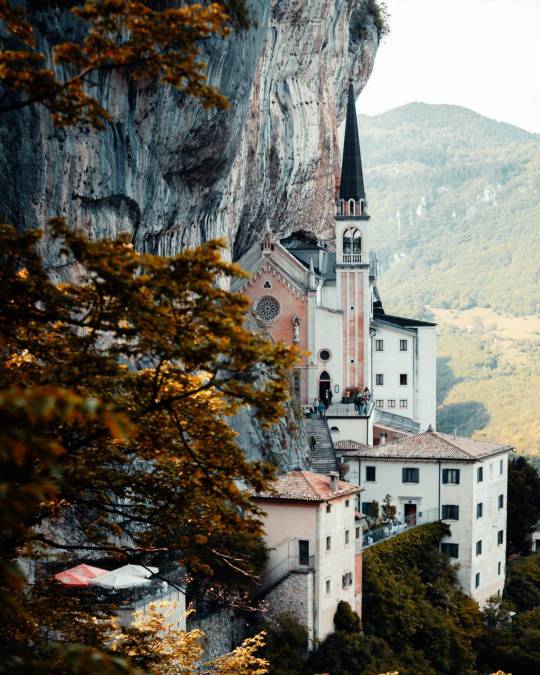









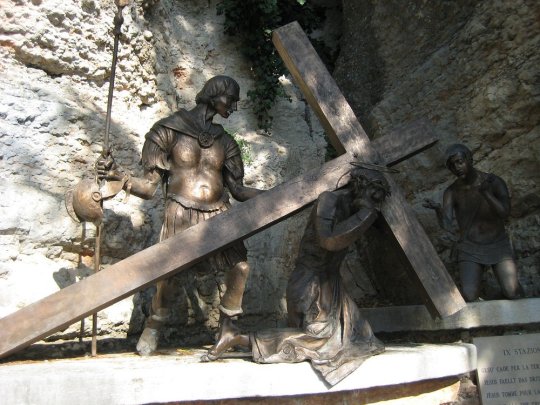



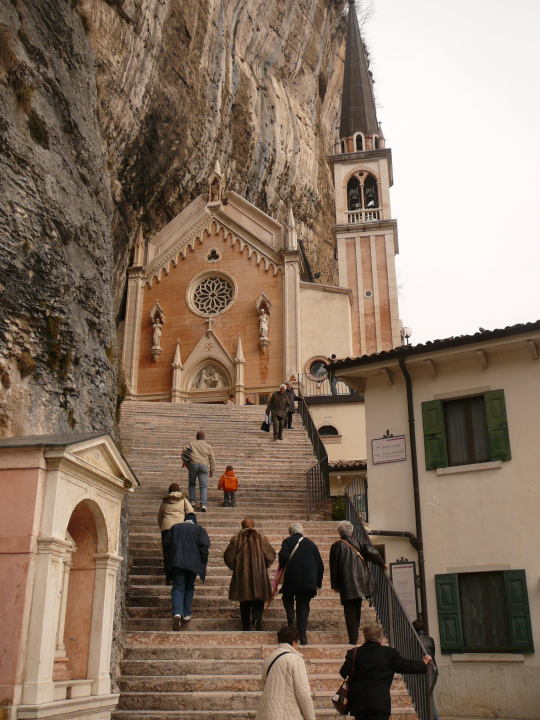
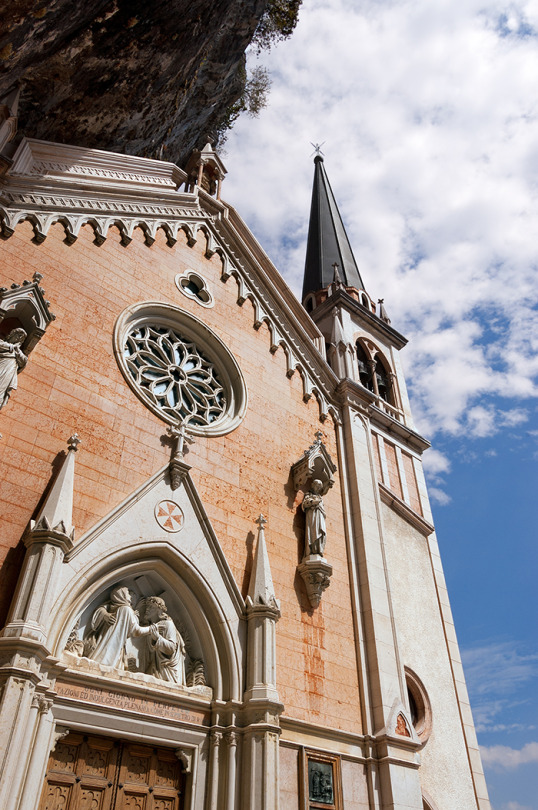




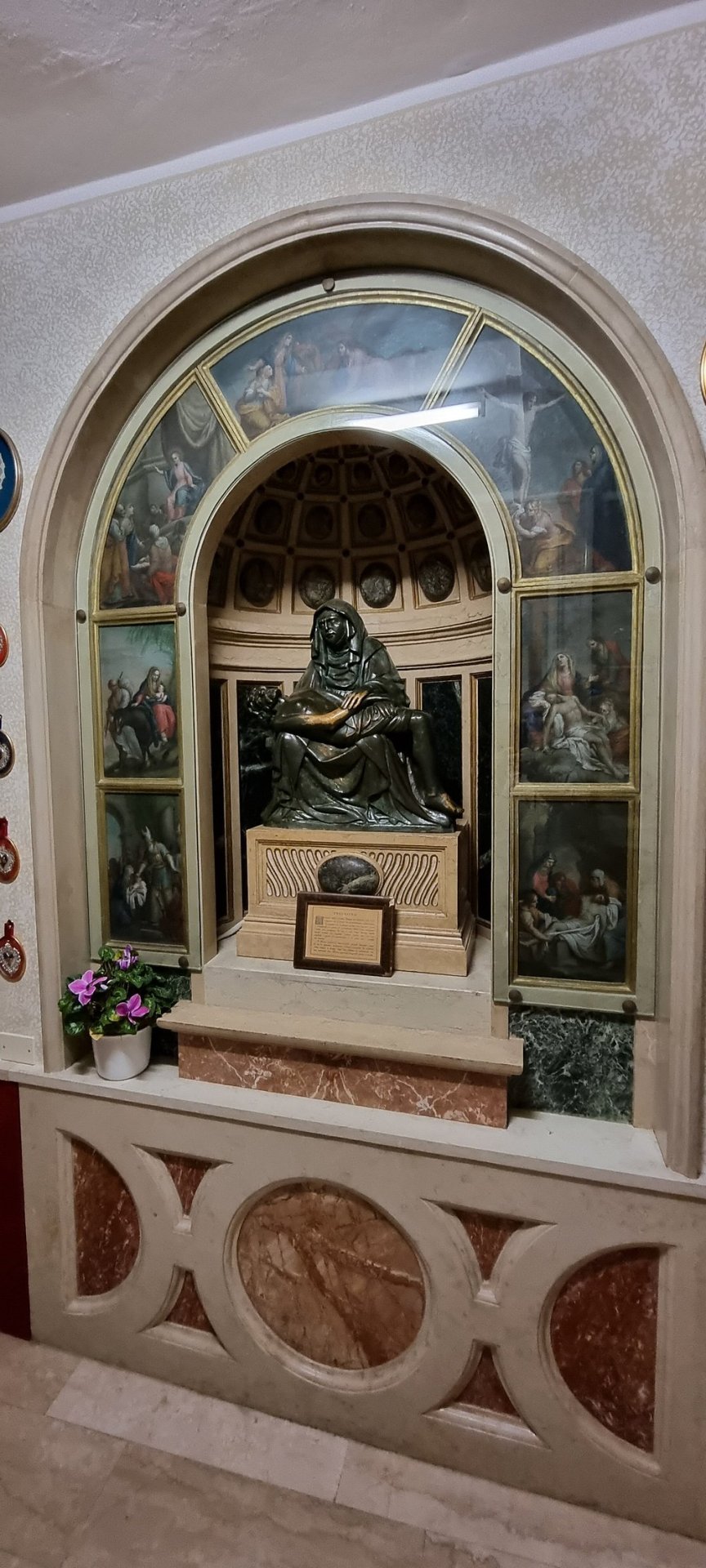



Святилище Богоматери Короны (Santuario Madonna della Corona).
Святилище Мадонны делла Корона находится в деревне Спьяцци, в провинции Верона. Этот церковный комплекс построен прямо в скальной стене горы Бальдо в Альпах, на высоте 774 метров над уровнем моря. Под ним расположена долина реки Адиже, а над ним возвышаются утес и бескрайнее небо.
Считается, что около 1000 года благочестивые отшельники, связанные с аббатством Святого Зено в Вероне, основали на горе Бальдо религиозное убежище. К XIII веку здесь уже существовал монастырь. По легенде, строительство святилища началось в 1522 году, когда статуя Мадонны чудесным образом была перенесена с острова Родос на это место «по воле ангелов» после захвата Родоса османскими войсками. В 1530 году на месте чуда была построена часовня, а через столетие — более крупная церковь. Последние значительные работы по реконструкции проходили в 1970-х годах под руководством архитектора Гвидо Тисато. Ранее, в XIX веке, святилище подверглось неоготической перестройке, но позднее его признали нестабильным. Сегодня оно полностью восстановлено и безопасно для посещения.
В средние века в монастырь снизу вела опасная горная тропа, и это был единственный путь. Впоследствии построили мосты, деревянные и каменные лестницы, затем — дорогу на горе, по которой теперь автобус доставляет людей. По лестнице паломники/пилигримы поднимаю��ся до сих пор. Тропа «Путь Надежды» начинается от города Брентино Беллуно. Вверх через лес ведут 1500 ступенек. В среднем на такой подъем в монастырь пилигримы тратят 2 часа.
Кроме того, внутри здания находится Святая лестница (Scala Santa), считающаяся точной копией лестницы во дворец Пилата, по которой Иисус поднимался, чтобы услышать смертный приговор.
Sanctuary of Madonna della Corona (Santuario Madonna della Corona).
The Sanctuary of Madonna della Corona is located in the village of Spiazzi, in the province of Verona. This church complex is built directly into the rock wall of Mount Baldo in the Alps, at an altitude of 774 meters above sea level. Below it is the valley of the Adige River, and above it rises a cliff and an endless sky.
It is believed that around the year 1000, pious hermits associated with the Abbey of San Zeno in Verona founded a religious retreat on Mount Baldo. By the 13th century, a monastery already existed here. According to legend, the construction of the sanctuary began in 1522, when the statue of the Madonna was miraculously transferred from the island of Rhodes to this place “by the will of angels” after the capture of Rhodes by Ottoman troops. In 1530, a chapel was built on the site of the miracle, and a century later, a larger church. The last significant reconstruction work took place in the 1970s under the direction of the architect Guido Tisato. Earlier, in the 19th century, the sanctuary underwent a neo-Gothic reconstruction, but it was later recognized as unstable. Today, it is fully restored and safe to visit.
In the Middle Ages, a dangerous mountain path led from below to the monastery, and this was the only way. Later, bridges, wooden and stone stairs were built, then a road on the mountain, along which a bus now takes people. Pilgrims still climb the stairs. The "Way of Hope" trail starts from the town of Brentino Belluno. 1,500 steps lead up through the forest. On average, pilgrims spend 2 hours on this climb to the monastery.
Also inside the building is the Holy Stairs (Scala Santa), which is considered an exact replica of the stairs to Pilate's palace that Jesus climbed to hear his death sentence.
Источник://t.me/borderlesstravel, /lifeglobe.net/entry/14697, /a-lex-7.livejournal.com/626492.html, /tourweek.ru/blogs/3449989, /www.tripadvisor.ru/Attraction_Review-g1785335-d3246292-Reviews-Santuario_Basilica_Madonna_Della_Corona-Ferrara_di_ Monte_Baldo_Province_of_Veron.html.
#Италия#история#архитектура#готика#классицизм#Святилище Мадонны делла Корона#храм#алтарь#статуи#лесница#горы и лес#Альпы#Italy#history#Architecture#medieval#church#Gothic#Classicism#Sanctuary of the Madonna della Corona#altar#statues#staircase#Alps#mountains and forest
161 notes
·
View notes
Text
Okay I think it’s time to say it but I think non keyblade wielders and key kids lived together in gothic scale but the wielders went to khdr scala and the nons stayed and formed radiant gardens this is my theory
24 notes
·
View notes
Text
I was thinking about how someone phrased khux's interaction with other worlds as "reckless interventionism" vs dark road Scala's "watch but never touch" philosophy and yknow,,,
We know in the age of fairytales, before the keyblade war and uχ, the world was one, unified World. Then the war, and later the fall, and eventually when the worlds start to reform they're separated. There's walls, paths that have to be guarded against by armor or black coats or ships. There's clear borders between worlds that hold their people, rulesets, time itself, largely separate.
In kh1:
Goofy: Oh, right... I gotcha. Ya mean, while we’re in other worlds, we can’t let on where we’re from. We’ve gotta protect the world border.
Donald: “Order.”
Goofy: Right. World order.
Goofy mixes words up, that's a recurring bit for his dialog. Goofy also is sometimes the first to pick up on important clues to the player, only for Donald to shut them down because it's Goofy. He's perceptive and unaware. And while I'm willing to file this under the mixing up words category, this is also kh, X on a shirt, etc.
So, what if it actually meant something? I don't think Goofy was in on the clue, but I do think it might have actually been one. That the philosophy of maintaining world Order is, whether understanding of it or not, is meant to maintain the worlds Borders. To what end kinda depends on who started the rule, which we can assume was during or after ML/Gothic scala.
I can think of two main reasons for the rule, from either helping or hindering the World as a whole.
If its to help: the borders may be acting as bandages, or more directly, scabs. The World/worlds are still healing, restoring to their once unified state. The borders may fade in enough time, or they'll require magic or keyblade weilders to remove them, but they need to be there.
But if its to harm: they were likely put in place by Darkness, directly or otherwise. All forms of the space between worlds we've seen are dangerous, either by the void itself or by monsters. If the worlds need to reach out as they recover, to reattach themselves, they can't. The borders are getting in the way, holding the wounds open.
And while I'm on the body and flesh metaphors, they could also be just. scar tissue. This idea feels a little weaker to me but it still felt worth bringing up.
I don't have a thesis statement for this i just remembered that line from Goofy and my brain started GOING. but I like this little theory and it's implications. either way I think it leads to the borders breaking down and the World being restored.
#im having coherent thoughts about kh for once wondrous day#kingdom hearts#kh1#kingdom hearts theory#kh3#khux#khdr#khx#kh world order#kh world border#kh analysis
14 notes
·
View notes
Text
You know how when you think a little too much about a joke theory it sort of stops being a joke? Anyway what if Ienzo’s parents were scientists in gothic Scala and then whatever disaster caused it to crumble started happening and they were like “okay Ienzo we can’t make it out of this but the legends say some people escaped the destruction of their world through dreams so we’re going to try something for you” and he got sent to the realm of sleep for a while and forgot everything and idk maybe absorbed illusion powers from there since a dream and an illusion aren’t too different and then when he finally got out of the dream he appeared in Radiant Garden and they were like “whoa where did this weird orphan come from” “idk it doesn’t really matter”
#kingdom hearts#ienzo#I highly doubt anything like this is going to happen but imagine if it did#me post#victorian orphan theory
31 notes
·
View notes
Text

On this day in sexploitation history: breast-fixated visionary Russ Meyer’s essential b-movie Lorna was released sixty years ago (11 September 1964). (Tagline: "Without artistic surrender, without compromise, without question or apology, an important motion picture was produced: LORNA - a woman too much for one man!”). I definitely would have seen Lorna at London’s Scala Cinema in the early 1990s, possibly on a double bill with Mudhoney (1965), the next film Meyer and memorable leading lady Lorna Maitland made together. (Meyer’s biographer Jimmy McDonough summarizes Maitland as “a stiff swirl of cotton-candy blonde hair, lips like a pair of overstuffed couches mating, a lethal-weapon body – there was something plain wicked about Lorna Maitland. Her terminally unimpressed scowl seemed to suggest your balls were not long for this world … A Venus flytrap in a wighat, Jayne Mansfield’s evil twin”). And I’ve never seen Lorna again, so my memory of it is a bit misty (sadly, whole swathes of Meyer’s filmography are currently difficult to see. His estate is chaotic). Anyway, Lorna represents the start of what Roger Ebert has termed Meyer’s “Gothic period.” For his part, Meyer said he was inspired by Bitter Rice (1949), calling Lorna his attempt at making an American interpretation of Italian neo-realism.
#lorna#lorna maitland#russ meyer#lobotomy room#sexploitation#60s sexploitation#sexploitation film#sexploitation cinema#sexploitation movie#exploitation movie#b movie#roughie#vintage sleaze#vintage smut
43 notes
·
View notes
Note
Man, the Gothic Scala aesthetic was unmatched, and exploring it was so fun (not to mention, the OST was GOATed)
Even if we somehow be able to explore it in a future title, I doubt we’ll have NPCs around (it’ll probably be like the Greek Scala in ReMind) and definitely not be able to have a customizable MC, so the vibes just won’t be the same…
~~~
12 notes
·
View notes
Text
What if they're Gothic fashion in Scala and Brain is so happy that Ephemer and his bloodline got into some nice fashion for once then learns that it's not called Gothic and something stupid like "Steampunk E-core fashion" even though it's CLEARY Gothic and Brain is so upset about it they just want to cry.
#He’ll be screaming and crying to the Player and Sigurd about it and Sigurd doesn’t really care but still tries to comfort him just because#kh#kingdom hearts#khml#sigurd kh#sigurd#Brain#kh brain#kingdom hearts missing link#missing link#kh missing link
68 notes
·
View notes
Text
expanding on my tags here a lil bit, I do think ml Scala is meant to take inspiration from multiple different european places but it really is very very italian to me. Like there’s the battle theme and architecture and potential symbolism yeah, but…hmm. Maybe I’m partly pulling from personal experience. I’ve visited Rome before so when I look at some of the shots in ml, mostly the nighttime ones, I just remember walking around the streets the first night I was there and how soft and warm the lighting was. It just feels the same to me somehow, which, if anything, is a testament to the amount of care and attention that was put into developing this version of Scala (from the devs themselves and in-universe ;) )
#roadie rambles#I’m fascinated by the progression of architecture between daybreak -> ml scala -> dr scala in general#bavarian to romanesque/gothic to cycladic…it’s like they’ve been giving us a tour of european architecture in this one world alone 😄 how fu#n#symbolic too perhaps#this is why I like to think early scala (overmorrow scala) is a bit different too; more cammarata and mont st michel#inspired#in my head scala just changes with every generation to suit the needs of the people#can’t tell if that would be fascinating or frustrating for a historian/archaeologist haha#anyway that’s my daily brain dump thanks for coming to the ted talk ❤️#scala culture
13 notes
·
View notes
Text
for now I’m still gonna refer to these different worlds as “Gothic Scala ad Caelum” or “Cycladic Scala ad Caelum” but I hope to god KH itself will eventually give us official terms to refer to them because I can’t live like this for too long
#khml#scala ad caelum#idk I dont fuck with ‘old scala/new scala’ or ‘white scala/grey scala’#even if the latter is very tlotr lmaoo
23 notes
·
View notes
Text
Why Should You Visit and Live in Milan?

Milan is one of Italy's most vibrant metropolises. This city is the best of both worlds, combining historical beauty and grandeur with world-class innovation. For instance, the city's ancient Gothic cathedral exists side by side with towering skyscrapers. The city is a hub for architectural enthusiasts as well as those interested in art, history, or the environment.
The city is home to numerous ancient and antique architectural masterpieces. The Milan Cathedral (Duomo di Milano) is one of the most imposing structures in the Milan Skyline. The cathedral borrows from Gothic architecture. Visitors are welcome to climb the rooftop terraces for a panoramic view of the city.
Bosco Verticale, also known as the Vertical Forest, represents urban living in Milan. This building comprises two residential towers adorned with over 20,000 plants. This vertical forest helps protect biodiversity and improve air quality.
The CityLife district was formerly a trade fair site. Today, the district is home to skyscrapers designed by Zaha Hadid and Daniel Libeskind. The district also has a very large green area. This expanse of green space is considered part of one of the largest car-free zones in Europe.
To address air pollution in the city, Milan established the ForestaMI initiative to plant three million trees by 2030. This deliberate attempt at reforestation will ensure the city has a green cover while combating the effects of climate change.
Milan is also known for its green roofs and walls. The CLEVER Cities program encouraged more people in Milan to install green walls and roofs across buildings. The program is a European Union-funded initiative that promotes sustainable urban regeneration. This solution is nature-based, helping to regulate temperature and manage stormwater.
Milan holds a prominent place on the global stage as a fashion hub. Twice a year, the city becomes the epicenter of international fashion with Milan Fashion Week, attracting designers, celebrities, and media from around the world. It's also the headquarters for iconic fashion houses like Prada, Versace, Armani, and Dolce & Gabbana. But Milan's influence doesn't stop at clothing; it's equally renowned for industrial and interior design. The Salone del Mobile, an annual design and furniture fair, transforms the city into a vibrant showcase of innovation and creativity, drawing professionals and enthusiasts from every corner of the globe.
Beyond its creative industries, Milan is a powerful force in Italy's political and intellectual life. It serves as a hub for national discourse, with major newspapers such as Corriere della Sera and numerous television studios based in the city. Think tanks, publishing houses, and cultural institutions thrive here, fostering a climate of critical thinking and informed debate. This strong media and academic presence helps shape public opinion and policy, making Milan not only a stylish city but also a thoughtful and influential one.
Finally, the city is home to renowned institutions like La Scala, one of the world's most celebrated opera houses, and the Pinacoteca di Brera, which showcases an exceptional collection of Italian Renaissance masterpieces. Throughout the year, Milan's cultural scene comes alive with a range of events, including operas, concerts, exhibitions, and film festivals, that attract both locals and visitors. Education and the arts hold a special place in Milanese society, supported by the city's leading universities.
1 note
·
View note
Text

Sancta Scala
I chose this place because the reverence and respect felt here was one of the most humbling experiences of my life. The building itself may not be the most grand, but it was certainly the most impactful.
The Holy Stairs became quite controversial during the Reformation. As a monk, Martin Luther visited the stairs in 1510 and ascended them on his knees as a penance. However, he later questioned the practice after learning that it was not a surefire way to be saved. His doubts about indulgences and the teachings of the Catholic Church grew as a result of this experience, which ultimately fueled the Protestant Reformation.
Something surprising I learned about this landmark was that everyone who ascends the staircase does so on their knees out of respect for Christ, who took those same steps.

The Beguinage
I chose this location because of the immense awe that I felt the moment I walked through the gate. It is such a humble and quaint area, but I think that might be why it stands out so greatly from most other things on this list. It represents simple beauty.
The Bruges Beguinage survived by becoming more closely aligned with Catholicism and eventually coming under stricter Church control, whereas many other beguinages were shut down or suppressed during the Reformation. Its persistence illustrates both the flexibility of certain Catholic communities in areas influenced by Protestantism and the larger religious conflicts of the time.
One thing that I found surprising about this place was learning that it now serves as a serene and peaceful place of habitation for nuns and single women.

Aix-la-Chapelle Cathedral
I chose this place because it has been one of my favorite religious buildings during my entire time in Europe and it just so happened to also be the first one we were able to see!
Even as Protestantism spread throughout the empire, it maintained a strong Catholic influence as the site of Charlemagne's burial and the coronation of German kings. During the Reformation, the cathedral itself remained a stronghold of Catholic tradition and imperial power, despite religious changes in the surrounding areas.
One thing that surprised me about this location was learning the entire story behind why it is so insanely ornate and how much influence Charlemagne had on the people of Aachen.

Basilica of St. Servatius/Church of St. John
I chose this location because it is not an incredibly common thing to see two religious buildings of different faiths standing so close to one another while also still being active. It was also quite eye-catching to see the stark contrast between the colors of the structures.
Thes two stood on opposite sides of the religious divide during the Reformation. St. Servatius remained Catholic, while St. John’s became a Protestant church after the Reformation swept the region. Their close proximity stands as a symbol of the religious tensions and coexistence that emerged in many parts of Europe during the Reformation era.
One thing that surprised me about this location was that the Church of St. John was also a Catholic building before being converted during the Reformation. I guess that would explain their close proximity!

Westminster Abbey
I chose this place because the gothic architecture caught my attention immediately and drew me in. It also meant a lot to me to be able to visit a place that has a history as rich as this Abbey and to better understand its importance.
It was originally a Catholic monastery, but briefly became a cathedral under Henry VIII and then became a foundational landmark in the Church of England's institutional years. It remained a central site for royal ceremonies, including Elizabeth I’s coronation, marking the Abbey’s alignment with the newly established Church of England.
One thing that surprised me about the Abbey was finding out that Isaac Newton and Stephen Hawking's tombs can be found there!
1 note
·
View note